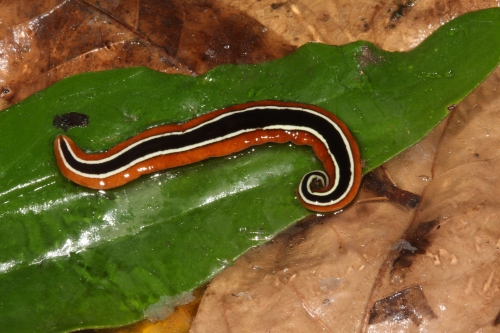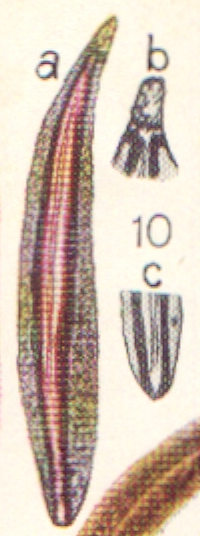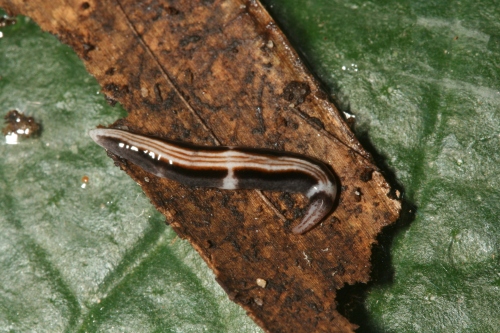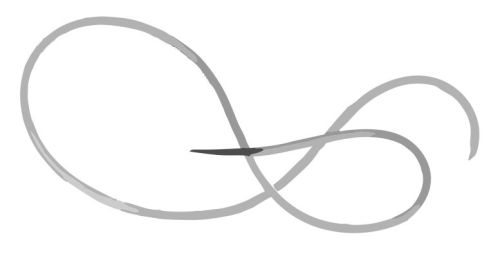by Piter Kehoma Boll
During his epic voyage on the Beagle, Charles Darwin visited Rio de Janeiro, Brazil, and collected some amazing land planarians, a group that until then was very little known. One of the species he found was Geoplana vaginuloides, the type-species of the genus Geoplana, at that time named Planaria vaginuloides.

Geoplana vaginuloides (Darwin, 1844), the first Brazilian land planarian species to be described. Photo by Fernando Carbayo.*
The second species described by Darwin was named Planaria elegans. Darwin’s description is as it follows:
“Position of the orifices as in P. vaginuloides. Anterior part of the body little elongated. Ocelli absent on the anterior extremity, and only a few round the margin of the foot. Colours beautiful; back snow-white, with two approximate lines of reddish brown; near the sides with several very fine parallel lines of the same tint; foot white, exteriorly clouded, together with the margin of the body, with pale blackish purple: body crossed by three colourless rings, in the two posterior of which the orifices are situated. Length 1 inch; breadth more uniform, and greater in proportion to length of the body, than in last species.
Hab. Same as in P. vaginuloides. [Rio de Janeiro]”
And this is all we know about this species. Darwin did not provide any drawing and later researchers did not report this species again, except when mentioning Darwin’s publication. As you can see by the description, it is not very accurate. He does not say what is the breadth of each line or band, neither how many of the “several fine parallel lines of the same tint” there are. Here is a quick drawing I did of how I imagine the creature would be:

My idea of what Darwin’s Planaria elegans may have looked like. Head to the left. Credits to myself, Piter Kehoma Boll.**
In 1938, Albert Riester described a land planarian from Barreira, a district in the city of Teresópolis, Rio de Janeiro, naming it Geoplana barreirana. He described it as it follows (translated from the original in German):
“Land planarian found on a leaf after a rain; greatest lenght ca. 20 mm. Middle of the back white with two fine purple-red (atropurpureus light) parallel stripes. Outside of the white also limitted by pale red, then follows (on both sides) a black band and laterally a black-brown marmorate pattern over brown background. The middle stripe ends at the rear [end]. Head spotted, marked with transversal spotted bands (regenerate?). Underside gray, bordered by black-brown. Anterior end is arched backwards.”
Fortunately, Riester provided a drawing, which you can see below:

Geoplana barreirana drawn by Riester (1938).
They look a bit alike, right? Fortunately Geoplana barreirana (currently named Barreirana barreirana) was found by later researchers and we have photographs! See one specimen below:

A specimen of Barreirana barreirana found in the Tijuca National Park, Rio de Janeiro. Photo by Fernando Carbayo.*
Riester did not describe any transversal marks on his specimens, but he may have mistaken them for color loss in preserved specimens or something like that. Otherwise the specimen looks very similar to Riester’s drawing, and the internal anatomy, which Riester provided as well, is also compatible.
Now let’s try to fit Darwin’s description of Planaria elegans in this photograph. White background, two reddish brown stripes and several fine parallel stripes of the same tint. He likely described the animals from preserved specimens, even though he have seen them alive and collected them. Perhaps the colors had already faded a little and the black stripes, which internally touch two of the reddish stripes, may have been considered a single purple-red stripe? It is not clear, in his description, whether there is white between the “reddish brown” stripes and the “pale blackish-purple” sides, as I did in my drawing, or not, as in Barreirana barreirana, but certainly the dark gray sides of B. barreirana could be the same as the pale blackish purple sides of Planaria elegans, don’t you think? And B. barreirana HAS three white “rings” crossing the body. You can see the first and the second very clearly on the specimen above. The third one is not very well marked, but you can see a third white mark interrupting the gray sides. And the second and almost third marks seem to be quite where one would expect the two orifices (mouth and gonopore) of the planarian to be!
And what about the ventral side? Darwin described P. elegan‘s as being white with a pale blackish purple border as the sides of the dorsum. Riester described G. barreirana‘s as being gray bordered by black-brown. Here is Barreirana barreirana‘s ventral side:

Ventral side of Barreirana barreirana from the Tijuca National Park, Rio de Janeiro. Photo by Fernando Carbayo.*
It is white, or pale gray perhaps, and the borders are of the same color as the sides of the dorsum!
I think it is very, very likely that Darwin’s Planaria elegans and Riester’s Geoplana barreirana are the same species. The fact that no one but Darwin has ever seen a specimen of Planaria elegans makes it even more likely.
What do you think?
– – –
See also:
How are little flatworms colored? A Geoplana vaginuloides analysis.
The fabulous taxonomic adventure of the genus Geoplana.
– – –
References:
Darwin, C. (1844) Brief Description of several Terrestrial Planariae, and of some remarkable Marine Species, with an Account of their Habits. Annals and Magazine of Natural History 14, 241–251.
Riester, A. (1938) Beiträge zur Geoplaniden-Fauna Brasiliens. Abhandlungen der senkenbergischen naturforschenden Gesellschaft 441, 1–88.
– – –
*
This work is licensed under a Creative Commons Attribution-NonCommercial 3.0 Unported License.
**
This work is licensed under a Creative Commons Attribution-ShareAlike 4.0 International License.



